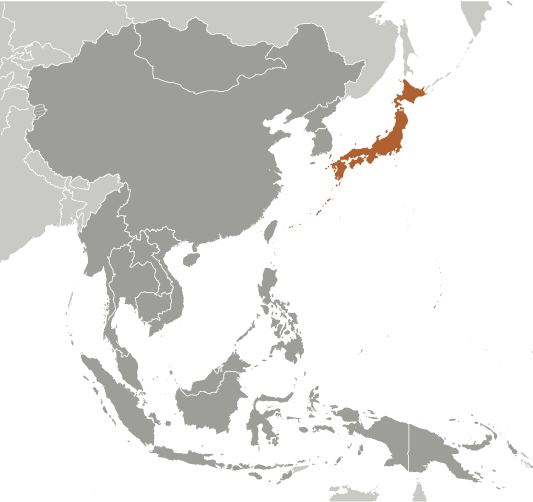

Facts about Japan

Japan map
Where is Japan?

Japan is in Eastern Asia. It is an island chain between the North Pacific Ocean and the Sea of Japan, east of the Korean Peninsula
National day
11th February is National Foundation Day (kenkoku kinen no hi).
Japan has a generous number of public holidays each year - fifteen. Only eight countries in the world enjoy more.

The Geography of Japan
Flag of Japan.
The national flag of Japan is a white rectangular flag with a large red disk (representing the sun) in the center. This flag is officially called Nisshōki (日章旗?, "sun-mark flag") in Japanese, but is more commonly known as Hinomaru (日の丸?, "circle of the sun").

Capital city of Japan
The capital city of Japan is Tokyo, which has a population 37,135,000 people in the Tokyo built up area. This makes it the largest city in the world.

Tokyo, Japan
Land Area
Covers an area of 377,930 sq km. (145,920 sq. miles)
62nd largest country in the world. Roughly the same size as Germany or Zimbabwe. Japan is half the size as Chile and twice as big as Syria.
Climate
It varies from tropical in the south to cool temperate in north. Winters are cold with heavy snowfall in the mountains in the north. Summers are long, hot and sunny.
Fertile soil, warm temperatures and plenty of rain mean that Japan is a country rich in vegetation as can be seen here in this bamboo forest.

Rich, fertile land.
The people of Japan

Healthy diet
Long life
The Japanese people enjoy the second highest life longevity in the world. Their healthy diet which contains a lot of fish is often held up as one of the reasons that Japanese people enjoy such long life.
Life expectancy for males is: 81.4 years
and for females is: 88.3 years
Population of Japan
Language of Japan
The population of Japan is 127,253,075 (July 2013 estimate). It is the 10th largest population in the world. Japan has 335 people per square km making it the 40th most densely populated country in the world.
Consititutional monarchy
Japan is a constitutional monarchy and this grand building is home to the government. It is called the National Diet building and it is in Tokyo.
Japanese is the language spoken in Japan.

Democratic country
A mountainous country
Japan is a mountainous country with relatively few areas of flat land. The mountains in this image are exaggerated but they do give an excellent idea of how little flat land there is.


Mount Fuji is the tallest mountain in Japan. At 3,776 metres tall it poses a challenging climb for those that wish to climb it. It is an active volcano.
Mount Fuji
Japan's tallest mountains
1 Mount Fuji 3,776 m
2 Mount Kita 3,193 m
3 Mount Okuhotaka 3,190 m
4 Mount Aino 3,189 m
5 Mount Yari 3,180 m
6 Mount Warusawa 3,141 m
A typical Japanese home
Modern Japanese homes are built to withstand strong earthquakes and often include a high number of environmentally friendly features, e.g. solar panels

Average family
The average family in Japan has 1.4 children. Elderly relatives may live with the family too making the family feel larger.
Urban or Rural?
94% of Japan's population lives in urban areas.
Largest cities in Japan
(Metropolitan area)
1 Tokyo 36,923,000 people
2 Osaka 19,341,000 people
3 Nagoya 9,107,000 people
4 Fukuoka 5,515,000 people
5 Hamamatsu 2,741,000 people
6 Sapporo 2,584,000 people
7 Sendai 2,169,000 people
8 Hiroshima 2,099,000 people
9 Utsonomiya 1,686,000 people
10 Okayama 1,647,000 people
A land of contrasts

New Tokyo
Tokyo is a densely populated city and the motorways are elevated over main roads to reduce the amount of space they take up. Tokyo has an extensive network of motorways which cost 700 yen to use.
Tokyo also has large parks and forests that are open to the public. For those that love hiking, Tokyo's suburbs and commuter trains extend right up to Mount Takao for some serious hiking.

Old Tokyo
Tokyo contains some of the highest land prices in the world resulting in many impressive skyscrapers.
Tokyo skyscrapers often have restaurants, art galleries and places to relax on their top floors. This is the viewing gallery at the top of a skyscraper in Roppongi Hills, Tokyo.

Calm and quiet in the busy city

Home
to robots
Japan is home to a modern economy which utilises a large number of robots. Indeed, Japan uses a lot of robots in its factories and makes 60% of the robots that are created around the world.
Japan has a long history of respecting the past and of cherishing the skills that individual craftsman acquire. This is Akihiro Maeta and he is deemed a living national treasure for his skill in pottery.

Home to
national living treasures
Videos for school - Japan
The Japanese National anthem.
Ten interesting facts about Japan all played in one minute
In this topic, we look at the geography of Japan. We look at facts about Japan and we see how Japan is a fascinating land of contrasts, from the traditional to the modern, from the unique to the exciting. We look at images of Japan and through these images, we start to gain an understanding of what Japan is like to live in as a country, and we learn how Japan compares with other countries around the world.
GEOGRAPHY OF JAPAN




